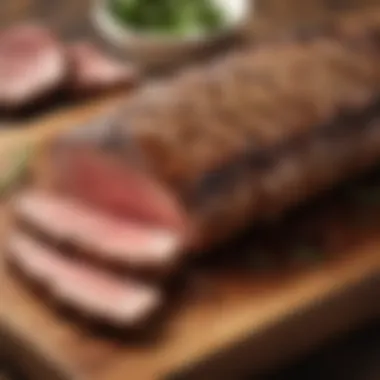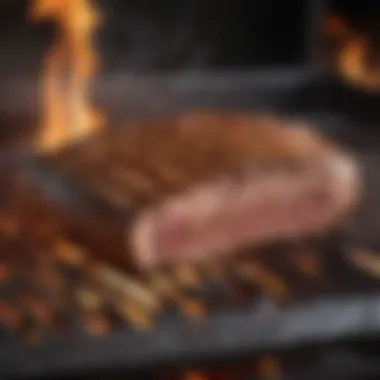Tri Tip Barbecue Recipe: A Comprehensive Guide


Intro
Tri tip barbecue is not just a dish; it is a culinary experience that resonates with many food enthusiasts. This cut of beef, derived from the bottom sirloin, has gained popularity in recent years due to its tenderness and rich flavor. The tri tip represents a balance between great taste and approachable cooking techniques, making it an ideal choice for both novice and experienced cooks alike.
The history of tri tip is rooted in California, particularly in Santa Maria, where it is often associated with traditional barbecue methods. Its preparation involves simple seasoning that enhances its natural qualities. This guide aims to provide comprehensive insights into mastering the tri tip barbecue, breaking down every step from seasoning to cooking and serving suggestions. The readers will discover how to adapt the dish to suit their personal tastes and dietary preferences.
Whether you are throwing a backyard barbecue or simply cooking for your family, understanding the nuances of tri tip will elevate your culinary skills. With this knowledge, you will not only impress your guests but also deepen your appreciation for this unique cut of meat.
Stay tuned as we delve deeper into the specifics of tri tip barbecue.
Foreword to Tri Tip
The tri tip holds a special place in the realm of barbecued meats. Understanding this cut of beef is essential for any cooking enthusiast looking to elevate their barbecue skills. Not only does tri tip offer a unique flavor profile, but it also provides the opportunity for various cooking techniques. Let’s delve into the specifics that define this cut and explore its rich history, which shapes its current popularity.
Defining Tri Tip
The tri tip is a triangular cut from the bottom sirloin of the beef. Approximately two to three pounds in weight, it is often characterized by its lean, tender quality. This cut is particularly well-suited for grilling due to its marbling. It can be enjoyed in different styles, from slices on a plate to sandwiches.
A notable feature of the tri tip is its versatility in cooking methods. The beef can be prepared using grilling, roasting, or even smoking. Each method offers a distinct flavor and texture, appealing to a broader audience of meat lovers. The optimal preparation of tri tip allows for a juicy, succulent outcome that pleases the palate.
History and Origins
The origins of tri tip are quintessentially American. It emerged in the mid-20th century, gaining prominence in California's Central Coast. The cut was relatively unknown before it became a staple at local barbecue joints. Over time, its fame spread, and it became a favored choice for backyard grilling.
Traditionally, tri tip was often seasoned simply with salt and pepper, allowing the beef's natural flavors to shine. As culinary techniques evolved, so did the recipes and marinades, broadening the scope of how this cut is prepared and enjoyed. The history of tri tip reflects the American spirit of innovation in barbecue culture.
Regional Variations
While tri tip is commonly recognized as a California specialty, various regions in the United States and beyond have adopted their own styles of preparation. In California, tri tip is often cooked over red oak wood, infusing it with a distinctive flavor. Alternatively, in the Midwest, it may be seasoned with different spice blends that reflect local tastes.
Other regions have created unique dishes featuring tri tip, incorporating regional spices and cooking techniques. The flexibility of this cut allows cooks to tailor their approach based on cultural influences, making it a delightful feature in diverse cuisines. Exploring these variations can add depth to the overall experience of grilling tri tip.
Selecting the Right Cut
Selecting the right cut of tri tip is essential for achieving optimal flavor and texture. The tri tip cut comes from the bottom sirloin of the cow and has gained popularity due to its rich marbling and beefy flavor. Choosing the correct piece not only affects the taste but also impacts the tenderness and juiciness of the final dish. Understanding the nuances of this cut will help you create a barbecue experience that stands out.
Understanding the Meat
Tri tip is known as a triangular piece of meat. Its unique shape makes it distinct from other beef cuts. This section has a good balance of lean meat and fat, contributing to its flavor. The marbling present in tri tip is critical as it melts during cooking, infusing the meat with a succulent taste. The internal structure consists of both fibers and muscle, which will dictate how it cooks.
When selecting tri tip, consider the size. A standard tri tip weighs between 1.5 to 3 pounds. Smaller cuts are often more tender, while larger ones can take longer to cook thoroughly. Look for a cut with a bright red color and consistent marbling throughout. Avoid cuts that appear dull or have excessive sinew, as these indications suggest lower quality.
Quality Indicators
Knowing how to identify high-quality meat ensures that the tri tip will be delicious once cooked. Look for the following quality indicators:
- Color: Fresh tri tip should have a bright cherry red hue. Any darkening can indicate age.
- Marbling: A higher level of intramuscular fat enhances flavor and tenderness. Look for even distribution of white specks across the cut.
- Texture: The meat should feel firm to the touch without excessive softness. A smooth surface is preferred, indicating good handling.
- Smell: Fresh meat has a clean scent. Off or sour smells suggest spoilage.
By focusing on these aspects, you ensure that your choice of tri tip will yield satisfying results during your barbecue. An excellent cut will provide a strong foundation for flavor development during the cooking process, leading to a meal that pleases the palate.
Preparation Steps
Preparation steps are crucial for achieving a great tri tip barbecue. Proper preparation can significantly enhance the flavor and tenderness of the meat. Each step is an opportunity to infuse flavors and ensure the cooking process goes smoothly. When undertaking this culinary endeavor, it is important to focus on the tools, techniques, and timing. Careful attention to these elements can lead to a more enjoyable eating experience.
Necessary Tools and Equipment
To prepare a tri tip, certain tools and equipment are essential. These will not only facilitate the cooking process but also help achieve the best results. The basic equipment needed includes:
- A sharp knife for trimming the meat.
- A cutting board for prep work.
- A large bowl or resealable bag for marinating.
- Measuring cups and spoons for accurate ingredient portions.
- A grill or smoker, depending on your chosen cooking method.
- A meat thermometer to check doneness.
Having the right tools makes a significant difference in both preparation and cooking. They help ensure that the flavors meld well while also maintaining the meat's integrity during the cooking process. The attention to detail in choosing equipment can enhance the end product.
Marinating the Tri Tip


Marinating is an important step as it infuses flavor and can help tenderize the meat. The marinade creates a delicious crust that improves the overall taste. It also adds moisture, preventing the meat from becoming dry during cooking.
Choosing a Marinade
Choosing a marinade involves more than just flavor; it also impacts the texture of the meat. A good marinade typically combines acidic ingredients like vinegar or citrus juices with oil and seasonings. This balance is critical for tenderness. The acidity breaks down the meat fibers, making it more tender. For tri tip, common marinades include:
- Soy sauce and garlic
- Red wine and herbs
- Citrus blends with herbs
These combinations enhance the beef’s natural flavor and can be adjusted to individual preferences. A well-chosen marinade not only elevates taste but also marries beautifully with the smoky notes from the grill.
Duration of Marination
The duration of marination plays a vital role as it determines how deeply the flavors penetrate the meat. A shorter marination time may provide surface flavor, while a longer period allows the marinade to infuse more thoroughly. Generally, marinating tri tip for at least four hours is recommended. However, marinating overnight can significantly enhance flavor profile and tenderness.
It is essential to note that overly long marination can have a detrimental effect. This may result in a mushy texture due to excess acid if left too long. Thus, balancing time with the marinade components is critical for optimal results.
Dry Rub Options
For those who prefer a different approach, a dry rub may be used. Dry rubs are typically a blend of spices and herbs that create a flavorful crust when cooked. Applying these rubs enhances the meat's natural flavor without the potential downsides of marinating.
Key Ingredients
Key ingredients for a dry rub often include:
- Paprika
- Black pepper
- Garlic powder
- Brown sugar
- Onion powder
These ingredients not only provide flavor but also create a beautiful crust, enhancing the barbecue experience. The sugar caramelizes when grilled, giving a delightful texture.
Application Techniques
Applying the dry rub requires attention to detail. A good technique involves patting the tri tip dry before application. This ensures that the rub adheres well. Generously coat the meat, and consider letting it sit for about an hour to allow flavors to meld. This process allows the spices to penetrate the surface, enhancing the overall taste.
Emphasizing the importance of both marinating and dry rubs can help readers decide on their preferred method. Each approach offers unique characteristics and can cater to different palates while preparing tri tip.
Cooking Techniques
Understanding the correct cooking techniques is crucial in preparing tri tip. The method you choose can significantly influence the flavor, tenderness, and doneness of the meat. Proper techniques not only enhance the natural characteristics of tri tip but also allow for creativity in preparation. Using the right cooking method can help maintain moisture and achieve desired flavor profiles.
Grilling Methods
Direct vs. Indirect Heat
The choice between direct and indirect heat has significant implications for cooking tri tip. Direct heat involves cooking the meat directly over the flame, creating a caramelized crust that is both visually appealing and flavorful. In contrast, indirect heat allows the meat to cook more slowly and evenly, promoting tenderness while reducing the risk of burning the exterior.
A key characteristic of direct heat is its ability to sear the exterior of the meat, which creates a rich, smoky flavor. This method is often favored for its quick cooking time. However, one should be cautious not to overcook or undercook, as the high heat can lead to uneven results.
Indirect heat, on the other hand, is a slower method that effectively retains moisture in the meat, making it a popular choice among many seasoned cooks for tri tip. It allows the meat to cook gently, achieving a perfect internal temperature without drying out. However, the downside includes longer cooking times, which may not suit some cooking preferences.
Time and Temperature Guidelines
Time and temperature guidelines are critical for achieving the perfect tri tip. These factors directly affect the meat's doneness and overall quality. One recommended approach is to use a meat thermometer to measure the internal temperature accurately. The ideal temperature for medium-rare is around 135°F, while medium sits at 145°F.
A unique feature of time and temperature guidelines is that they provide flexibility. Cooks can adjust cooking times based on the thickness of the meat and their desired level of doneness. Following these guidelines helps ensure that the tri tip retains its juices, making it a delicious and satisfying meal.
Smoking the Tri Tip
Wood Choices
Wood choices play a vital role in the smoking process, affecting the flavor profile of the tri tip. Different types of wood provide distinct flavors; for instance, oak is often praised for its balanced profile, while hickory offers a stronger, smoky taste. Choosing the right wood is essential for creating a flavor that complements the meat.
Using fruit woods like apple or cherry can introduce a subtle sweetness to the tri tip, enhancing its natural flavors. A common mistake is to use woods that are too intense, which may overpower the meat. Therefore, understanding the characteristics of various woods is key to achieving optimal results.
Temperature Control


Temperature control is another crucial aspect of smoking tri tip. Maintaining a consistent smoking temperature, ideally between 225°F and 250°F, allows for thorough cooking while infusing the meat with smoke flavor. If the temperature fluctuates too much, it can result in uneven cooking and a compromised texture.
A unique feature of temperature control is that it enables cooks to manage the smoking process actively. Using a quality smoker thermometer can help maintain optimal conditions, ensuring that the tri tip cooks evenly. Attention to temperature can ultimately elevate the final dish.
Sous Vide Techniques
Equipment Overview
Sous vide equipment includes immersion circulators and vacuum sealers, which are fundamental to this cooking technique. This method ensures precise temperature control, allowing the tri tip to cook evenly from edge to edge. As a result, the meat can achieve a perfect medium-rare doneness without the risk of overcooking.
The advantage of using sous vide lies in the ability to achieve exceptionally tender meat. The low-temperature cooking process breaks down tough fibers without losing juices, producing a juicy and flavorful tri tip. However, it requires specialized equipment, which may be a barrier for some.
Final Prep for Grilling
Final prep for grilling is essential in ensuring the perfect finish for the tri tip after sous vide cooking. It often involves searing the meat on a hot grill to develop a flavorful crust. During this stage, it is important to pat the meat dry and season it accordingly, which enhances the final flavor.
This step is crucial, as it combines the benefits of sous vide and grilling, resulting in a tender interior with a deliciously charred exterior. However, one must be careful with timing during the grilling stage; too much heat can lead to overcooking, negating the careful temperature control achieved during the sous vide cooking.
By understanding these techniques, cooks can confidently approach preparing a tri tip, resulting in a flavorful and satisfying meal.
Serving Suggestions
Serving suggestions are pivotal in enhancing the overall dining experience of tri tip barbecue. They not only complement the meat but also provide an opportunity to showcase creativity and cater to different tastes. When serving tri tip, presenting it in a visually appealing way can significantly improve the meal's enjoyment. Additionally, the right accompaniments can balance the dish's rich flavors, ensuring a satisfying meal.
Plating Techniques
Plating techniques are critical in elevating the presentation of tri tip barbecue. A well-plated dish can make the meal feel more gourmet. Start by slicing the tri tip against the grain, which helps maintain tenderness. Lay the slices on the plate in a slightly overlapping manner to create depth. A simple garnish, such as fresh herbs or a drizzle of sauce, can add a touch of color and flair without overwhelming the dish. Make sure to leave space on the plate for other components, allowing each element to shine without overcrowding. Consider using contrasting colors and textures on the plate to enhance visual appeal.
Accompaniments and Sides
Accompaniments and sides are essential in constructing a complete meal with tri tip. They should balance the robust flavors of the meat, offering freshness and texture. Here, we explore two essential categories of sides: salad pairings and starch options.
Salad Pairings
Salad pairings are a good way to add vibrancy to the plate. A fresh salad can cut through the richness of the tri tip and cleanse the palate. For example, a simple arugula salad with a light vinaigrette combines nutty and peppery flavors. The crispness of the greens contrasts nicely with the tender meat. Adding seasonal vegetables can enhance both nutrition and flavor. Regardless of the specific salad choice, the key characteristic is freshness, which makes it a beneficial and popular option when serving tri tip. Leafy greens provide a unique feature, as they often contribute essential vitamins while offering a variety of textures. However, it is also important to ensure that the salad dressing does not overwhelm the meat's flavor.
Starch Options
Starch options, such as potatoes or rice, provide a hearty counterbalance to the meal. A classic baked potato with toppings like sour cream and green onions complements the savory tri tip. Alternatively, creamy polenta can offer a comforting, soft texture that pairs well with the meat. The key characteristic of starch options is their ability to absorb flavors, making them a beneficial addition to tri tip. This enhances the overall experience of the dish. Additionally, starches can be uniquely versatile. They can be prepared in numerous ways, from roasted to mashed, allowing for personalization in the meal. However, one should be cautious in choosing starch combinations that can overshadow the tri tip's flavor profile.
Popular Sauces and Condiments
The role of sauces and condiments cannot be overlooked in the context of barbecue. They serve not only to enhance the flavor of grilled foods but also to contribute to the overall dining experience. Tri tip's robust flavor profile invites a variety of accompaniments, allowing enthusiasts to personalize each meal. Furthermore, sauces can introduce delightful contrasts in taste and texture, thus elevating even the simplest barbecue.
Barbecue Sauce Types
When it comes to barbecue, sauce selections are diverse, reflecting regional influences and personal preferences. Each type of sauce can dramatically alter the taste of tri tip. Here are some recognized styles:
- Texas-style: Traditionally made with tomato, vinegar, and spices. It tends to be thicker with a mildly sweet flavor.
- South Carolinian: Mustard-based, this sauce offers a tangy yet savory component that works surprisingly well with the rich taste of tri tip.
- Kansas City-style: Known for its sweet and sticky consistency. Brown sugar and molasses dominate its flavors, complementing the meat's richness.
- North Carolina: Vinegar-based with a peppery kick. This offers a sharp contrast that can help balance the richness of the tri tip.
Alternative Toppings
The use of alternative toppings can significantly enrich the overall experience of tri tip barbecue. More than just a flavor boost, these toppings can add texture and color, making the dish visually appealing.
Pickles and Onions
Pickles and onions bring a crucial element to barbecued dishes. Their acidity helps cut through the fatiness often found in meat, creating a harmonious balance. Pickles offer a crisp texture, while onions, depending on how they are prepared, can provide a spicy, sweet, or sharp kick. This combination is a beneficial choice for enhancing the tri tip’s flavor without overshadowing its natural meatiness. The contrasting textures can make each bite more interesting for the diner.
Cheese Varieties
Including cheeses in the mix can bring additional layers of flavor and richness to tri tip barbecue. Each cheese variety has its characteristics:
- Cheddar: Its sharpness can complement the robustness of tri tip nicely. It melts well, creating a creamy layer.
- Pepper Jack: Infused with herbs and spices, Pepper Jack can add a zesty kick.
- Blue Cheese: Though strong, its unique flavor can be enjoyable for those who appreciate bold tastes.


Each cheese selection can elevate tri tip dishes, but there’s an inherent trade-off. Too much cheese can overpower the meat’s flavor, so balance is key.
The range of sauces and toppings available allows for creativity and adaptation, making the tri tip barbecue an ever-evolving culinary experience.
"The right condiment or sauce can transform an ordinary meal into a culinary adventure."
Variations of Tri Tip Recipes
Exploring variations of tri tip recipes is essential because it opens a new world of flavors while retaining the beloved characteristics of this cut. Adaptations allow cooks to cater to varying taste preferences and dietary restrictions. Additionally, regional influences and health trends shape how tri tip can be prepared, introducing new techniques and spices that can elevate the dish.
Global Influences
Tri tip has seen many interpretations across the globe, reflecting diverse cooking traditions. From the smoky barbecue flavors of American cuisine to the bold spice blends in South American dishes, each region contributes a unique flair.
For instance, an Argentinian take features chimichurri sauce, which combines parsley, garlic, and oil for a zesty finish. This accompaniment contrasts with Mediterranean methods that emphasize marinating with herbs like rosemary and thyme, often highlighting local olives and balsamic vinegar in the mix. There are also Asian-infused recipes, which might utilize soy sauce and ginger, providing a sweet and savory profile.
When exploring global influences, cooks should consider:
- The spice level and how it fits with their palate.
- The availability of ingredients, as some specific items might be hard to find in their local region.
- The cooking method prevalent in those cultures, which may include grilling, pan-searing, or even sous vide.
"Culinary exchanges enrich our cooking practices and encourage experimentation in the kitchen."
Health-Conscious Alterations
Health-conscious variations of tri tip recipes cater to those who are mindful of their dietary intake while still enjoying delicious food. One common alteration involves reducing sodium. Using herbs and spices for flavor instead of salt can maintain the taste without unhealthy levels of sodium.
Another consideration is selecting leaner cuts or trimming excess fat on the tri tip itself. This allows for a more favorable fat-to-protein ratio without sacrificing the juicy texture that tri tip is known for. Furthermore, incorporating more vegetables into servings can enhance nutritional content.
Some popular health-conscious methods include:
- Grilling or baking the tri tip instead of frying to lower added fats.
- Using low-sugar marinades or marinades that are rich in herbs for flavor enhancement.
- Pairing tri tip with a large serving of vegetables or a whole grain salad, providing fiber and vital nutrients.
These variations not only retain the essence of tri tip but also meet the needs of those looking for healthier meal options. By being flexible with the traditional recipe, anyone can enjoy tri tip in a manner that aligns with their health goals.
Storage and Reheating
When enjoying a delightful tri tip barbecue, it's crucial to consider how to store and reheat leftovers properly. This topic deserves attention because improper handling can lead to food waste, loss of flavor, or even spoilage. Proper storage techniques can extend the life of your tri tip, while correct reheating ensures that the meat retains its delicious texture and taste. Understanding these aspects not only helps in minimizing waste but also enhances the overall gastronomic experience.
Proper Storage Techniques
Storing your tri tip properly should be a priority as soon as the meal ends. Cooling the meat rapidly is essential. Allow the cooked tri tip to sit at room temperature for no longer than two hours before moving it to the refrigerator. It is advisable to slice the tri tip into smaller pieces. This increases surface area and allows it to cool faster, reducing the time it spends in the temperature danger zone (between 40°F and 140°F).
For storage, consider the following:
- Use airtight containers or wrap the tri tip tightly in plastic wrap or aluminum foil. This will prevent moisture loss and minimize exposure to air, which can cause the meat to dry out.
- Label containers with the date of storage. Typically, tri tip can be stored in the refrigerator for up to three to four days. If you need to keep it longer, it's best to freeze.
- To freeze, make sure the meat is well-wrapped to avoid freezer burn. It can last for about three to six months in the freezer.
Reheating Strategies
Reheating tri tip properly is crucial to maintaining its savory attributes. Here are several recommended methods to ensure the meat remains tender and flavorful:
- Oven Reheating: Preheat your oven to 250°F. Place the tri tip on a baking sheet covered with aluminum foil. Heat for about 20 to 30 minutes, checking frequently to prevent overcooking. You might add a splash of broth to keep it moist.
- Stovetop Reheating: Slice the tri tip and add it to a skillet over medium heat. You can add a touch of broth or water, cover with a lid, and allow it to steam slightly. This can help retain moisture and enhance flavor.
- Microwave Reheating: If time is short, this method is quick. Place the sliced tri tip on a microwave-safe plate and cover with a damp paper towel. Heat in short intervals, such as 30 seconds, until warmed through. Be cautious not to overheat, as this could dry out the meat.
Reheating is an art. The goal is to warm the meat without ruining the texture or flavor. Choose the method that best suits your needs and time available.
When stored and reheated correctly, tri tip can still be a delightful meal even days after the initial barbecue. Enjoying well-preserved leftovers reflects a commitment to both the culinary craft and sustainability.
Finale
In the realm of outdoor cooking, mastering the tri tip barbecue is not just about preparing a meal; it is a celebration of flavors and techniques. The significance of the conclusion lies in reinforcing the key aspects discussed throughout this guide. Whether one is a novice or a seasoned pitmaster, understanding the nuances of tri tip can elevate their barbecue experience. This article has unpacked intricate details from selecting the right cut of beef to exploring diverse cooking methods. The attempt here is not only to impart knowledge but to inspire a deep appreciation for a cut that embodies both tradition and culinary potential.
Recap of Key Points
To extract maximum enjoyment from the tri tip barbecue, various elements must be remembered:
- Selecting the Right Cut: Choosing a quality tri tip is essential for achieving a tender and flavorful result.
- Preparation Methods: Marinating or applying a dry rub sets the stage for enhancing taste. Each method brings out different flavors.
- Cooking Techniques: Mastering grilling or smoking techniques, including temperature control, is vital for reaching the desired doneness.
- Serving Suggestions: Understanding how to plate and what sides to offer can elevate the dining experience. The right accompaniments allow the tri tip to shine.
- Variations and Adaptations: Recognizing that personal preferences and dietary needs can reshape a recipe supports creativity in cooking.
"The beauty of barbecue lies not only in its taste but also in the story it tells through every bite."
Encouragement for Experimentation
The world of barbecue is ever-evolving, and the tri tip serves as an excellent medium for culinary expression. Every cook is encouraged to try their unique twists on the basic recipe. Consider altering marinades, experimenting with different woods for smoking, or even combining flavors from various cuisines. Health considerations might lead to lower-sodium rubs or alternative sides. There are no strict rules; the journey of culinary discovery is personal.















